The island faces a challenge of visibility, with barriers imposed by imperial neglect, poor urban infrastructure and a lack of local arts journalism. But discoverability and visibility can come at a cost
In late January, Puerto Rican Senate President Thomas Rivera Schatz proposed a bill that would dismantle the Institute of Puerto Rican Culture (ICP), the island’s principal cultural institution, and reduce it to a programme under the Department of Economic Development and Commerce. In a statement, the Center for Puerto Rican Studies at Hunter College, New York (also known as El Centro), summarises the bill’s goals in plain English: ‘Senate Bill 273 effectively eliminates the intrinsic value of preserving and disseminating Puerto Rico’s cultural trove by reducing it to just a tool for economic marketing.’
After announcing his bill, Rivera Schatz asked ICP leadership for balance sheets, expenses and budgets dating back to 2018. He claimed that if people want to accuse him of devaluing the arts through his bill, the documents would prove “who is truly responsible for abandoning our heritage and letting it deteriorate”. While it’s true that the ICP has struggled in recent years, the institute’s union and culture workers across the island point instead to budget cuts and outdated public policy as the source of the ICP’s inefficiency, and have organised to demand public hearings for Bill 273. But Rivera Schatz has opted to accuse the ICP’s Luminary Award-winning executive director, Carlos Ruiz Cortés, of living like a ‘king’ while the institution crumbled. Ruiz Cortés stepped into the role in 2017 and presided over the ICP through a 90 percent budget cut and a 60 percent slash in personnel, the devastations of hurricanes Irma and María, as well as 2020’s earthquakes and the COVID-19 pandemic.
Since receiving the 440-page report in late February, Rivera Schatz has yet to come forth with the explosive proof of malfeasance he seemed so certain it would contain. A conservative newspaper aligned with Rivera Schatz’s party wrote about the contents of the report and found that Ruiz Cortés was making about $75,000 a year as executive director – overseeing 18 departments including the National Archives, the National Library, the National Art Collection and two theatres; and presiding over the Musical Arts Corporation for two years – in a colony with higher utility costs than those found in any of the 50 US states, and a market marred by high consumer taxes and prohibitive import costs. When Ruiz Cortés announced his resignation in early March, Rivera Schatz, notorious for his smear campaigns and intimidation strategies, declared victory on social media: ¡Se los dije! (I told you so!)
The ICP, and Puerto Rican cultural production more broadly, have been in existential trouble for a long time. As the decolonial movement spread around the world in the mid-twentieth century, Puerto Rico’s struggle was stifled by the imposition of a complicated political status: that of an unincorporated territory that ‘belongs to, but is not a part of’ the US. This remains the overly complicated status today. The ICP was founded in 1955, a year before the FBI’s COINTELPRO violence against the civil rights movement introduced ‘carpeteo’ into the local lexicon (referring to folders of information gathered through citizen surveillance). Art that was even subtly political, critical or representative of alternatives to the status quo had to adapt to these institutional hostilities. So what is the environment today for art and cultural practices?
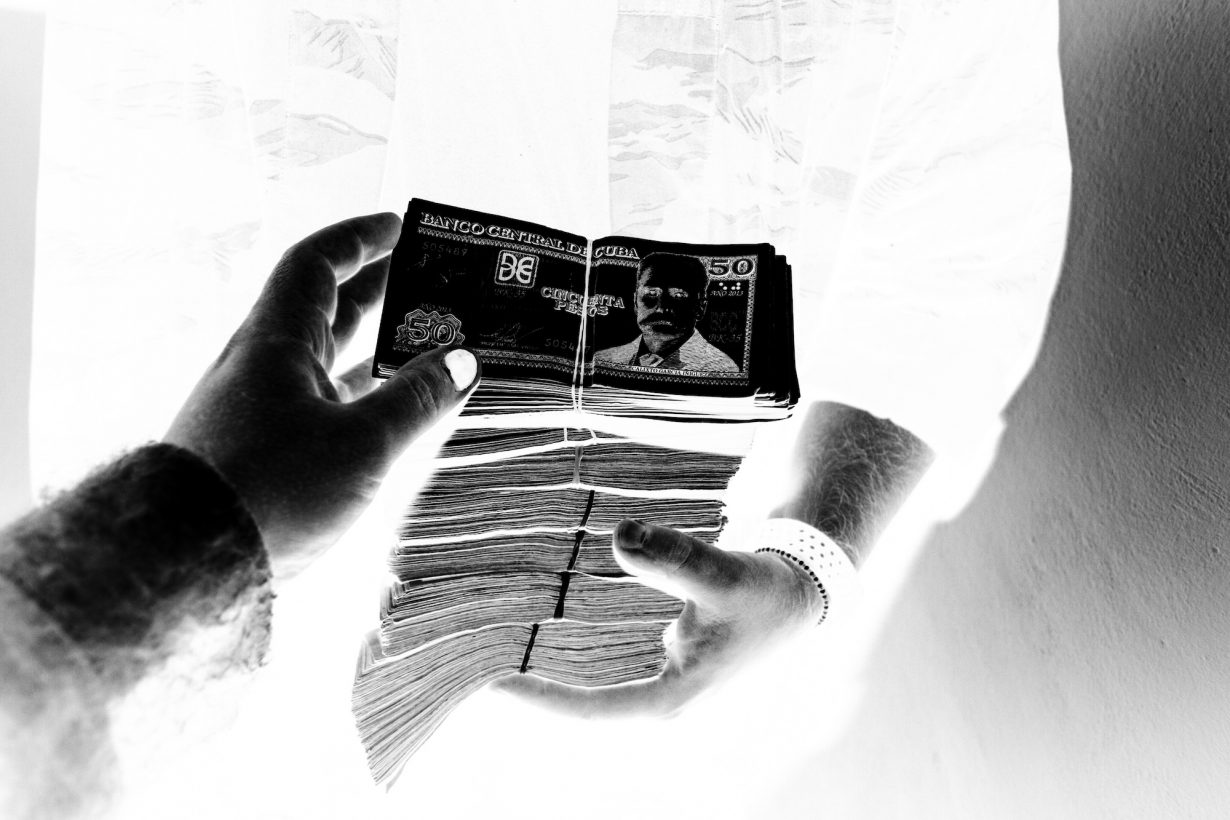

Driving west on San Juan’s Ponce de León Avenue last April, I was excited to find that GGK, the Guerilla Graffiti Kru – an anarchist tagging collective – had tagged one of the empty facades overlooking one of the city’s busiest intersections. The phrase read: Fuera Gringos del Caribe (Gringos out of the Caribbean). I looked for it every time I drove past, but by the end of March it had been painted over.
Thirteen years ago, the wall on the other side of the intersection used to have a mural of a grotesquely giant iguana (an invasive species) holding a coquí (a native frog) in its fist. The mural was painted by Belgian street artist ROA for the inaugural edition of Los Muros Hablan, an international street art festival cosponsored by the local contemporary art museum and Coors Light. Along with another art festival, Santurce es Ley, Los Muros Hablan heralded the early waves of gentrification in San Juan’s Santurce district, once one of Puerto Rico’s most densely populated areas and home to more foreign-born inhabitants than any other part of the island. It was an exciting if awkward time for politically charged art. I remember going to Santurce after school and on the weekends as a teenager during the early 2010s, when all things street art immediately recalled the Instagrammability of a millennial-pink wall. At the time, a local critic had derided the whole scene for embracing ‘brooklynizing’ trends that traded in ‘the aesthetics of change without the ethics of change’.
Despite the cringe factor of the tropical hípster, the city’s artists made decent use during this era of the new visibility the murals brought to the island, publicly challenging everything from neocolonialism to misogyny. A few blocks down from the iguana mural, and across the street from the hospital where I was born, another mural remains thick with the layers of a censorship struggle: in 2015 a local women’s rights organisation had commissioned a mural depicting a Black woman from two points of view – close up and far away – holding her arms over her face while standing naked in a swirl of butterflies. La Colectivo Moriviví had not yet finished its mural about gender-based violence when a bra and panties were painted over the work in crude white paint. The debate over censorship consumed local media when more politically charged murals – that is, anything that evoked Puerto Rican nationalism or criticism of the United States – were blotted over with the same kind of paint. In 2021, however, when the local government declared a state of emergency following a spike in femicide rates, Colectiva Moriví was able to restore its mural, memorialising the censorship struggle through the use of flesh-tone pixels to cover the larger set of nipples.
This public art boom gave way to a mid-2010s surge in contemporary art spaces able to capitalise on the visibility of street art. In 2015 alone, three now-major galleries – El Kilómetro, El Cuadrado Gris and Embajada – opened their doors. During the past decade they have become art fair regulars known for multipurpose spaces that activate communities and nurture rising talent from around the world, including Puerto Rican artists who have been featured in the Whitney and Venice biennials and nabbed prestigious residencies in Spain and Latin America. Embajada, for example, opened to New York Times coverage and has since been a regular fixture at NADA New York and Miami, The Armory Show (where it won the Sauer Prize for best booth in 2022) and Feria Material in Mexico City. The space closed for renovation in the spring and will return with a summer group exhibition called Museo del Reguetón. But if you don’t belong to that narrow sliver of people who keep up with artworld happenings and know their way around the San Juan metropolitan area, you might not have heard about these spaces. Puerto Rico’s controversial tourism campaign – ‘Discover Puerto Rico’, which has been accused of being out of step with the culturally diverse reality of Puerto Ricans – launched in 2017 and it describes Santurce as a ‘colorful, vibrant and artsy’ neighbourhood ‘reminiscent of Miami’s Wynwood Arts District or Chicago’s West Loop’. Its short list of must-see galleries only names a few in Old San Juan (the main tourist destination) and a handful near Guaynabo (suburban, affluent, conservative) that mostly offer modernist paintings (many decent) and the kind of abstract or photorealistic paintings made large enough to fill out tall second-home walls.

Recently at El Kilómetro’s main space, Havana-born artists Reynier Leyva Novo and Leandro Feal probed their experiences with political repression in Cuba for a joint show, Una brisa en el trópico (A Breeze in the Tropics), which was on view through March. With rich black-and-white stills of glamorous parties and debauchery, Feal’s La fiesta vigilada (2015–24) video piece surveys the Cuban glitterati’s last days of carefree partying before the government cracked down on the anti-communist San Isidro Movement. On the opposite wall, light from Leyva Novo’s flashing neon 1898 (2025) spilled out onto El Kilómetro’s bar-lounge area. That year marked the end of the Spanish-American War, when Cuba’s and Puerto Rico’s joint struggles for liberation were split apart: Cuba gained its independence, while Puerto Rico gained new rulers, their twinning colour-reversed flags waving as a fading reminder.
El Kilómetro’s minimalist signage stands out on the poorly lit street, its door small and quiet across from empty lots and a Walmart security watchtower. This March, its secondary space featured the inaugural show of the artist collective Sabroso Project, Papelón: Obras en Papel. Papelón, which contains the Spanish word for paper, papel, is slang for a messy or out-of-control situation. Curators asked over a dozen artists – many Puerto Rican, most working out of multiple cities – to consider ‘paper’s enduring yet delicate nature as an artistic medium’. The small space was painted by muralist Gabriel ‘Gloso’ Nieto to look like baby-pink paper had been torn in stripes to reveal a sky-blue background; glossy magazine pages and ephemera dangled from the rafters above. On one wall, Mariceliz Pagán Goméz’s Problematicæ (2025) hung as a delicate little vitrine containing dozens of detrituslike paper sculptures using foam, cotton, insect pins, seashells and other materials to create a macabre collection of anaemic shades and textures. On the opposite wall, Shingo Yamazaki deconstructed the Hawaiian textile motif in Gunpla (2025), an oil on paper drawing of a hand assembling a Gundam plastic model. And notable performance-art collective Poncili Creación dotted the walls with Dulces (2021), a triptych of products spread throughout the space – a cigarette, a blunt and a carton of cigs – each encased in plastic over hand-drawn pieces of cardboard reminiscent of corner-store wares. Behind the gallery space, offices on lofts look over studios used by artists like Awilda Sterling-Duprey, a dancer and choreographer who piloted an early version of her 2022 Whitney Biennial performance at El Cuadrado Gris, on the other side of Santurce.
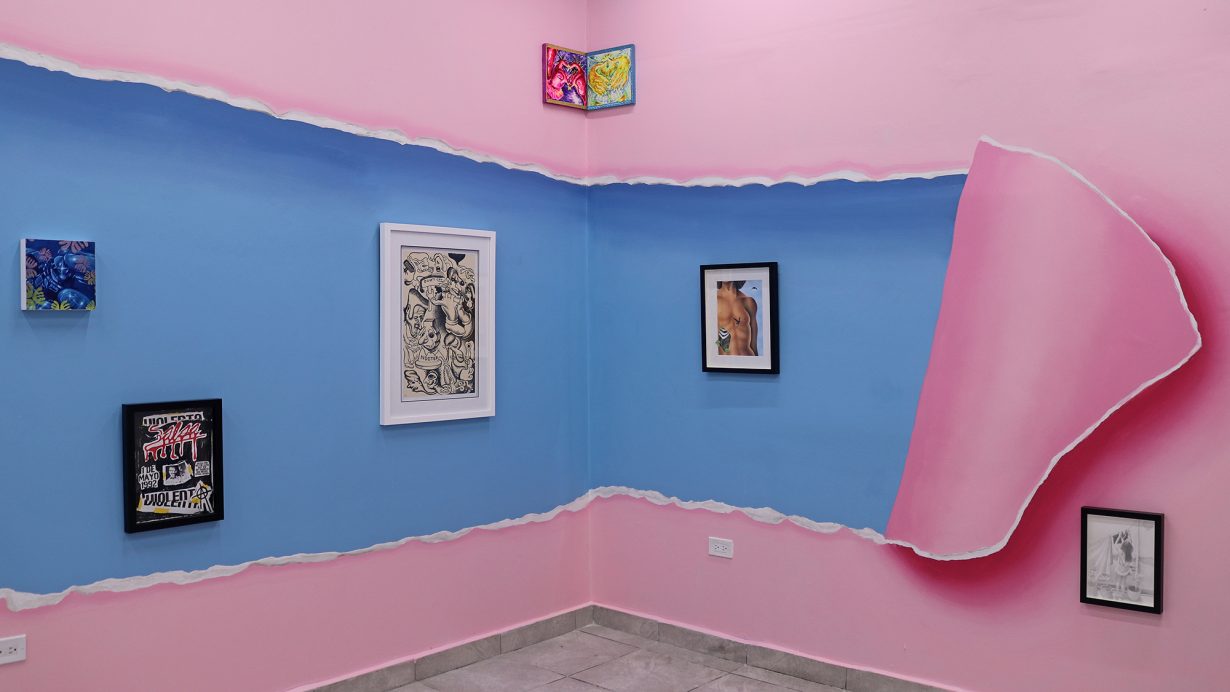

El Kilómetro’s is a relatively walkable corner compared to the crumbling buildings and perilously cracked sidewalks that obscure the paths to nearby galleries. All the galleries mentioned, except for El Cuadrado Gris, are bookended by the Puerto Rican Museum of Contemporary Art (MACPR) in the west and the Puerto Rican Museum of Fine Arts (MAPR) in the east, ideally sprinkled along a 750m strip primed for leisurely days of museum and gallery hopping. But Santurce can be unwalkably dense with cars, roosters and wet trash. The galleries that have crowded along the routes of past street art festivals are thriving despite the discoverability barriers imposed by neglected infrastructure. To add to the challenge, these spaces are often run by artists, who need to earn their living elsewhere and therefore keep limited opening hours, or are best visited by appointment. Add to that a considerable lack of local arts journalism, and the shadow of obscurity over Santurce’s contemporary art scene becomes clear. But discoverability and visibility come at a cost. After all, what good has discoverability historically done for Puerto Rico, anyway?

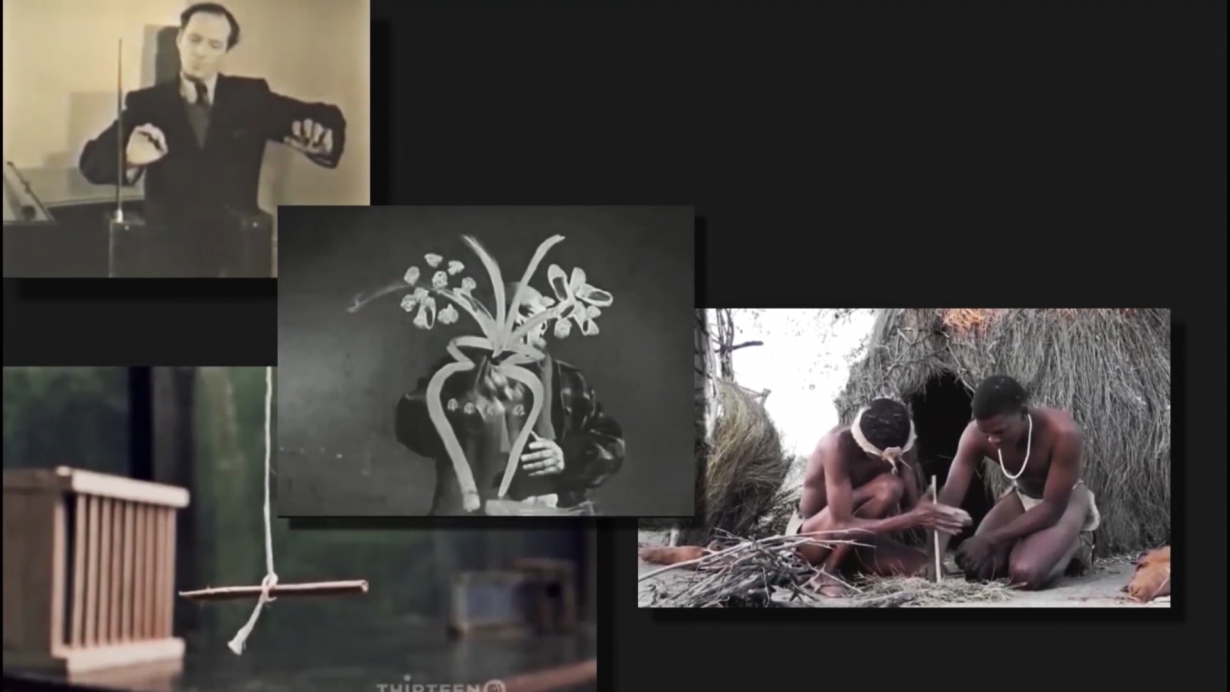
After Hurricane María killed nearly 3,000 people and wiped out the country’s power grid in 2017, Puerto Rico has had to contend with an unprecedented level of visibility. Headlines turned into attention (or more cynically, morbid curiosity), and urgency turned into opportunity. The first piece of writing I ever sold, for example, was about the hurricane’s impact on Boston’s Puerto Rican community. I moved to New York soon after and found that the artworld there was starting to take notice, too. In 2022, the Whitney put on no existe un mundo poshuracán: Art in the Wake of Hurricane María, the ‘first scholarly exhibition focused on Puerto Rican art to be organised by a large US museum’ in over 50 years. In 2023 Loíza-based sculptor Daniel Lind-Ramos had a solo show at MoMA PS1, while Pepón Osorio’s My Beating Heart took over the New Museum with installations of childhood bedrooms and neighbourhood barber shops. Later that year, MoMA acquired a performance-based work by Carolina-based artist-sisters Las Nietas de Nonó and four videoworks by San Juan native Sofía Gallisá Muriente. And in 2024 Pablo Delano’s ongoing installation The Museum of the Old Colony was featured in the 60th Venice Biennale, Foreigners Everywhere.
And yet the most significant recent publication on Puerto Rican art focuses primarily on the issue of visibility and representation: ‘Puerto Rico’s colonial status has rendered all Puerto Rican artists invisible to art scholars and institutions worldwide’, write Arlene Dávila and Yasmin Ramirez in their introduction to Nuyorican & Diasporican Visual Art: A Critical Anthology (2025), launched at a reception at MACPR. It’s a basic fact that, nevertheless, has also served as a crutch for Puerto Rican and Diasporican art criticism more broadly – and a claim that, despite its good intentions, overvalues visibility to the point of becoming blind to its limits.
MAC en El Barrio, an exhibition on view in MACPR’s main galleries through July, commemorates the last decade of the institution’s community outreach programme. Echoing the name of El Museo del Barrio in Harlem (founded by Diasporican artist Raphael Montanez Ortiz), the exhibition gathered a decade’s worth of art, including photographic documentation ofJoaquín Octavio’s Anoxia (2022), where the artist partnered with La Trinchera dance collective for a performance set in the mangroves of the Ciénaga Las Cucharillas nature reserve in Cataño. The dancers wore linen, and their muddy bodies are pictured half-absorbed by the landscape around them. These images are hung across Ada del Pilar Ortiz’s Treinta años en un día (2023), a cube-shaped wooden frame draped in latex-painted fabric, a display of ruinous and decayed textures that reiterate the crumbling structures that have come to overwhelm that same part of Cataño.
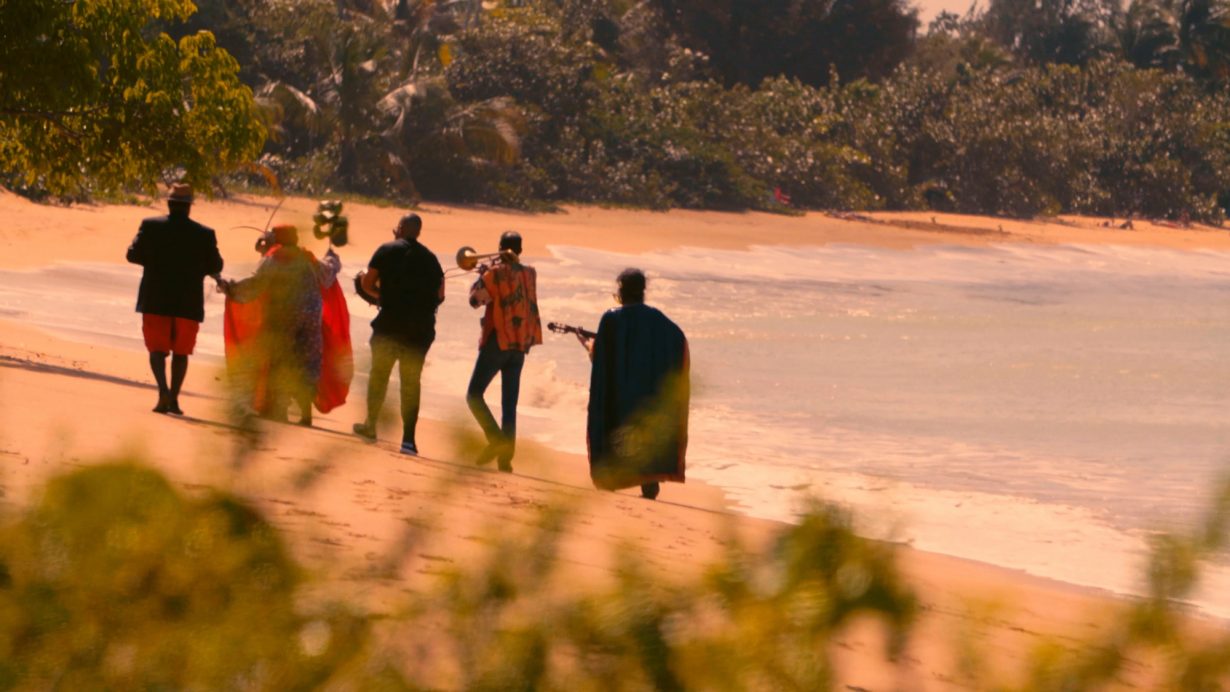
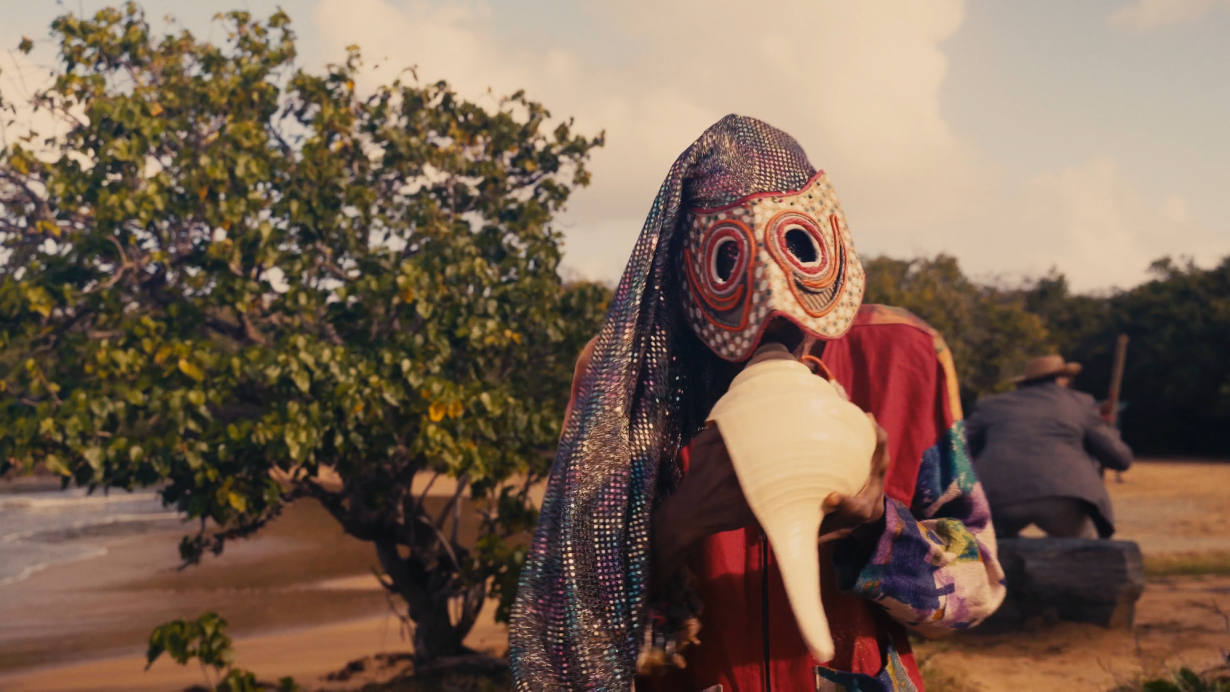
Beyond the tributes to San Juan’s iconic hand-lettered signage (created as part of a workshop series hosted by famed local sign painter Omar Obdulio Peña Forty), I found one piece I’d seen before: Daniel Lind-Ramos’s Talegas de la memoria (2020). I was in my fourth year of living in New York, and I remember sitting through various loops of this 15-minute video when it was on view at MoMA PS1 as part of a solo survey in 2023. Originally commissioned by MACPR, Talegas is set on a beach in Loiza (the artist’s home and birthplace), a historically Black township, and tells the story of San Mateo de Cangrejos, the island’s first community of self-emancipated slaves, spread out across in what is now known as Santurce, Hato Rey and Isla Verde (which abuts Loiza). Masks, shrouds and protective FEMA-tarps (distributed by the government in the wake of disasters) make up the bulk of his wardrobe. The piece had been previously shown simultaneously in New York and Santurce.
As my own journey through life and empire guided me from Puerto Rico to New York, and then back once more to the island after five years in the US, I started to understand how all Puerto Rican art is at least a little bit Diasporican. Santurce’s galleries – like El Kilómetro, Embajada, Pública Espacio, Cuadrado Gris, Hidrante and El Lobi and more – are actively showing works by local and Diasporican artists, both at home in Santurce and across the US, in Mexico and in Spain. Their activities are as diasporic as we are: Pública Espacio has collaborated with the Abrons Arts Center in creating La Residencia, a residency supporting artists in the diaspora. And the Artists Alliance Inc / Cuchifritos Gallery + Project Space connects artists from both ends of the diaspora to Manhattan’s Lower East Side, once a historically Puerto Rican neighbourhood. Santurce’s art scene updates our understanding of the Puerto Rican community as a whole by making apparent how economic and ecological trends in the archipelago and the mainland are scrambling the vectors that once diverged Puerto Ricans and the Diasporicans into two separate, albeit tenuously connected, communities.
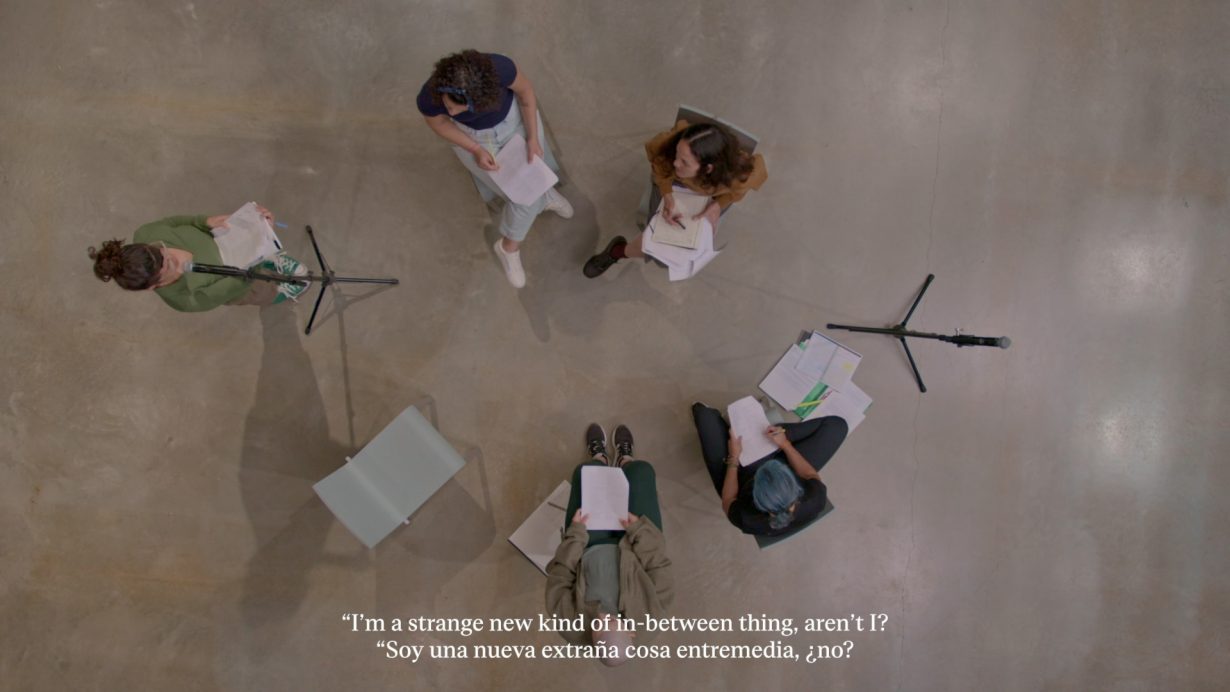

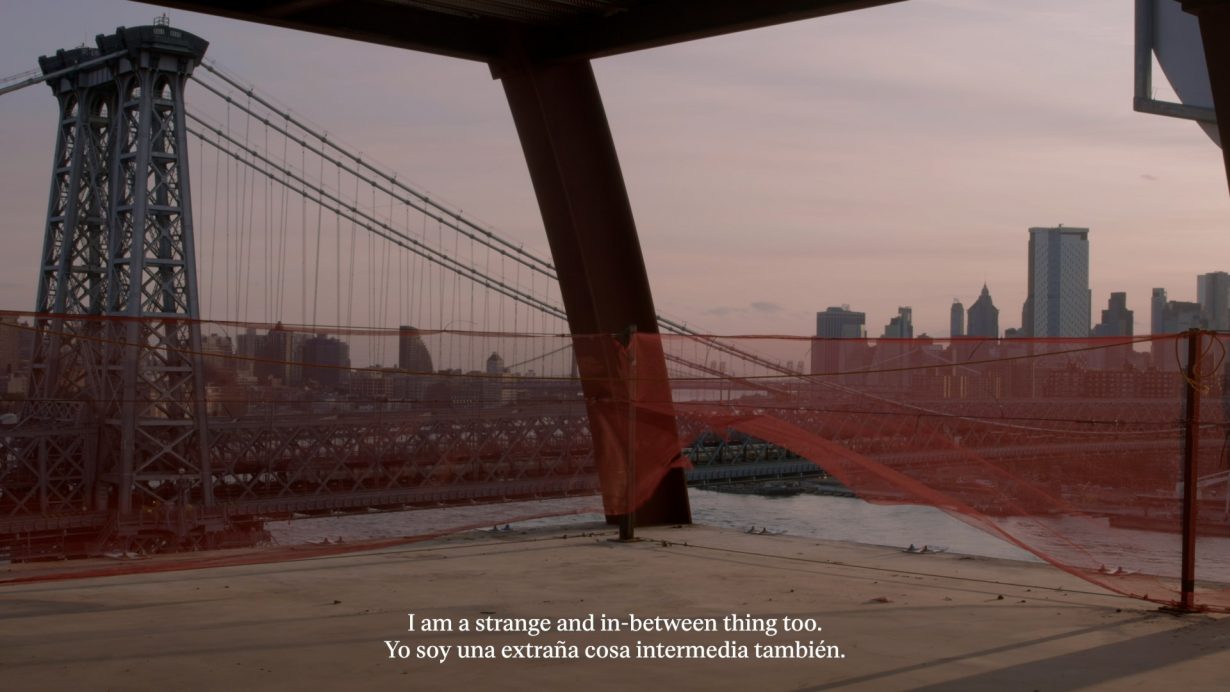
When I wrote the story about Puerto Ricans in Boston in 2018, I spoke to people who had come to take shelter with family but had every intention of returning to Puerto Rico as soon as things stabilised. I spoke to Diasporicans who took flights down to PR to distribute aid and returned with plans to rejoin their islandside families long-term. Our artists and gallerists are not immune to these forces. This spring, artist Natalia Lassalle-Morillo partnered with Pública Espacio to host an open call for the second part of her ongoing piece, En Parábola/Conversations on Tragedy (Part II), a sprawling reassemblage of the Greek myth of Antigone for the complexities of the Puerto Rican diasporic experience. Part I was conducted in New York with amateur Nuyorican actors and was presented at Amant Foundation in Brooklyn through a series of live performances and a multichannel film installation that layered footage from the rehearsal process, behind-the-scenes moments and staged reenactments as written and performed by the cast members. The multiyear project continues with Part II featuring Puerto Rico-based actors (amateurs, as well) who will participate in an open-rehearsal period in two places in PR. Lassalle-Morillo’s website explains how En Parábola ‘seeks to connect these communities after decades of geographical fragmentation, colonial erasure, dispossession, and cumulative environmental, economic and political tragedies’. It’s a dialogue that takes place across oceans and diasporas, a work of art that is both from here and from over there.
Santurce’s artist-gallerist-curator hybrids have practices and bodies of work that respond to ‘the expansion and decentralisation of the Puerto Rican diaspora’ described in Dávila and Ramirez’s Nuyorican & Diasporican Visual Art. With expansion and decentralisation comes diffusion, and specificity is pluralised: ‘Whereas Nuyorican could once adequately serve as a signifier for all Puerto Ricans in the diaspora,’ they write, ‘that is simply no longer the case,’ as ‘the diaspora has expanded geographically and now doubles the population of the archipelago’. As the people of the archipelago continue to refract across the empire, there is not just one Puerto Rico, there are many. And these artists work across multiple Puerto Ricos. Perhaps contemporary Puerto Rican art is less visible than one might wish because it’s blurred by the motion of its constant movement. And maybe that’s a good thing.
This is not to dismiss the systemic discrimination that slowly suffocates livelihoods and creative practices. But to beg for visibility is to constantly keep ourselves on the verge of discovery, unable to accumulate knowledge or build on lessons learned, too easily defined into a commodity form amenable to tourists and philistines alike. We’ve reached a point where we’re better served by more nuanced degrees of visibility and invisibility. The contemporary artists working out of Santurce spread their practices across the ocean – often out of necessity – and the results are practices and works that embody the continuities of empire and the discontinuities of colonialism, a scene that is more diffused and harder to pin down than many would like. Perhaps visibility has already done all it can. Maybe Puerto Rico has already been discovered enough.
Michelle Santiago Cortés is a writer and critic based in Puerto Rico
